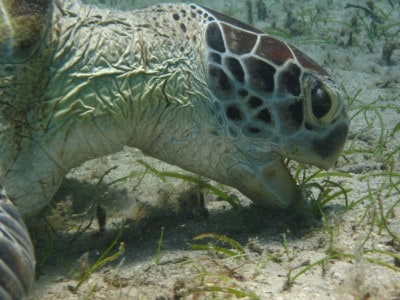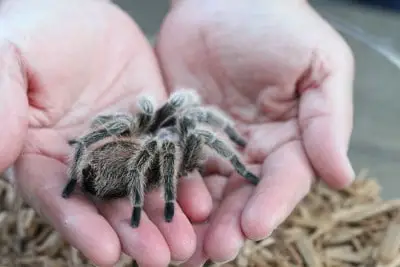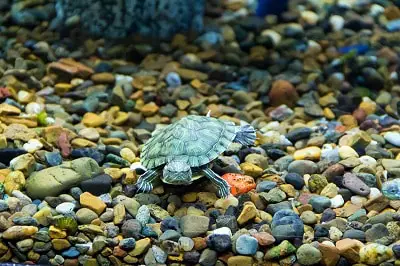Turtles spend a significant part of their lives in water and the rest on land. Since they seem to be comfortable outside the ocean for a while, you may wonder how they would cope while living exclusively on land.
Turtles can last only a few days without water. This is because they need the water to rehydrate, cool down, and smooth their body processes. However, some aquatic species like the painted and red-eared sliders can last up to a week, while the terrestrials like the box will be okay for months.
If you are interested in knowing how long turtles can go without water, this is the guide for you. Read on to understand why turtles need water, how long they can live without water, and what makes them go without water.

Do Turtles Need Water?
Most of the earth’s surface is covered with water, and all living creatures depend on it for survival. However, aquatic animals like fish would die without it, making turtles exceptional due to their ability to survive in both water and land. They spend some time ashore, which begs the question of whether they can survive without going back into the ocean.
Turtles rely on water to survive. Since they are cold-blooded animals, cold water is their only way of cooling down after basking in the sun. If they spend a long time under the heat, their bodies can overheat, which is risky. They also get dehydrated and weak without it. However, they can last longer when it is cool and wet on land. They cannot go for long if it is scorching because they get dehydrated faster, and the extreme heat only escalates it. The longer they stay under the hot sun, the worse it is on their survival. However, terrestrial turtles can go longer without water than aquatic turtles.
Turtles are one of the few terrestrial and aquatic creatures; they feed in water and bask outside. Interestingly, they can die if they stay underwater for too long. They usually emerge to breathe then hold their breaths as they dive. Similarly, they cannot remain ashore for too long because they need to hydrate, cool down when it’s too hot, and hunt for aquatic prey.
They quickly succumb to the extreme heat since they cannot internally regulate their temperatures. They also need water to aid in digestion and smooth metabolic processes. It is easier for terrestrial species like the box turtles who need less water to survive and others who obtain water from food with high water content.
How Long Can a Turtle Live Without Water?
Water is essential for every turtle species for improved health. Although turtles are known as aquatic reptiles, they can get out of water due to specific reasons. Surprisingly, we also have terrestrial turtles that can live on land too. We investigated how long your turtles stay without water.
Various turtle species can go without water for different periods. The aquatic species cannot survive for as long as the terrestrial species. Some species can stay offshore for a few hours to bask, while other species can last days, weeks, or even months depending on the state of their health and other considerations. The longer your pet stays out of the water, the more it gets dehydrated, which has a direct negative impact on its health. Ultimately, researchers state that most turtle species spend approximately forty percent of their lifetime on land and the remaining time in the water. Similarly, they can last a couple of days at a time without drinking water.
Like the box turtles, the terrestrial ones only need some water to drink and dip in when it gets too hot. Notably, temperature levels play a crucial role in your pet’s survival outside water; low temperatures will initiate lower metabolism, which reduces the need for water. Regardless of the species, your pet needs a lot of water to swim, soak and drink, and without it, your turtle’s life will be in danger.
What Makes a Turtle Go Without Water?
Several contributing factors enable the turtle to stay without water. We will look at the significant reasons they would stay ashore for a long time and how essential it is for them.
Basking
Like any other reptile, turtles are cold-blooded creatures, meaning that they rely on external factors to help regulate their temperatures. The best and only way to warm their bodies is by basking. The sun’s heat cannot seep through the water, and they have to emerge and rest on the ocean shores while in the wild. Due to this, turtle owners need to help their pets by creating basking areas (platforms) where they can relax and absorb UVB lighting.
It is best to take them out of the water for some hours every day to dry, rest and bask. The UVB will facilitate calcium synthesis, which helps prevent MBD (Metabolic Bone Disease). Apart from thermoregulation, basking also speeds up metabolic processes and improves the body’s immunity against fungal and parasitic infections.
Age
Your turtle’s age is a contributing factor to how long it can stay without water. Compared to juveniles and old turtles, middle-aged pets can spend a long time ashore. It comes easy for them since their bodies are mature enough to help them control themselves. Life on the outside consumes a lot of energy and all the resources while trying to stay alive. In contrast, a younger turtle has a developing system. Hence, it will find it strenuous to live for long on land. In totality, a juvenile can only stay for a couple of days without water. Healthy adults, in contrast, can go past a week if all factors are constant.
Hibernation
This stage is when the turtles become inactive and sleep most of the time due to the low winter temperatures. At this time, the reptiles can survive outside water since they don’t take food or water. The animal’s body’s metabolism is below optimum due to the extreme cold. These conditions usually last for months in some regions.
This climate will determine how long the reptile brumates while utilizing the previously stored energy. Therefore, it is advisable to provide high protein foods at this time. Aquatic turtles prefer hibernating below the water surface, while the semi-aquatic would instead cover themselves with plant remains or rest in tree trunk hollows.
Weather Conditions
Turtles will stay in hibernation provided that the environmental temperatures and humidity remain constant. They will wake up when the levels rise but will stay put when it’s too cold, consequently affecting how the animal can live without water. Heat leads to water loss in their bodies, whose response is the need for more water to increase the reservoir. Typically, the turtles alternate between water and land to regulate body temperatures. A more humid environment can encourage your buddy to stay out of water longer and vice versa.
Species
There are two main turtle species, aquatic and terrestrial, with most falling under the former. The Red-Eared, Spotted, Mud and Painted turtles are aquatic but are among the few that stay long without water. The Red-Eared, for instance, can last a week when in hot climates and a month when it is humid. Their counterparts, the Painted species, are not as hardy but can also spend a couple of days without water.
Lastly, the musk species can outdo both of them with a reported case of some going months without water. The issue is different for the terrestrial box turtles. They don’t necessarily live in the water, but they need it to drink and ease bodily functions. We advise that you provide some water to soak in or mist them regularly to help them cool down and rehydrate. You can also feed them foods rich in water to replenish their reserves.
Finally
You wouldn’t want to put your pets’ lives in danger by keeping them away from the water. Whether they are aquatic or terrestrial, water is essential for their survival and without it, they will strain and suffer. Water helps them hydrate, cool down after basking for a long time, and comes in handy to assist in digestion and metabolic processes.
It would be best to have an aquarium for your aquatic turtle and keep the water crystal clear because they tend to drink as they swim. However, it is best to provide a water dish for drinking water and a shallow one for soaking if your buddy is terrestrial. Remember that your pet may only have some days to survive out of the water, especially if it is juvenile or old since these groups usually have weak systems.
Read more:



![Can Box Turtles Swim? [Truth Revealed] Can Box Turtles Swim](https://coolpetsadvice.com/wp-content/uploads/2021/05/Can-Box-Turtles-Swim-400.jpg)




